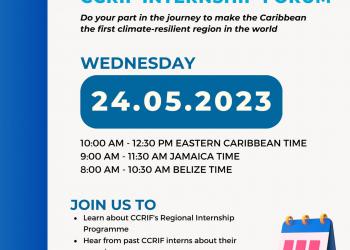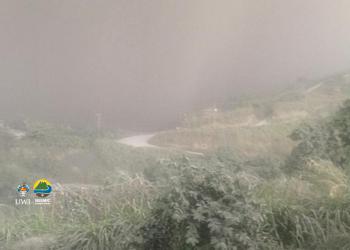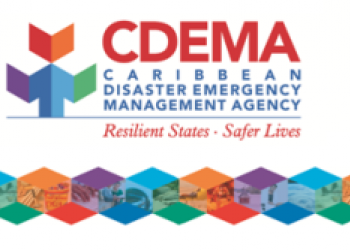
DRRC News
 |
Caribbean be warned: El Niño looking more likely |
Media release For further information, please contact the University Marketing and Communications Office via email at universitymktgcomms@sta.uwi.edu ----------------------------------------------------------------------------------------------------------------------------------------------- For Immediate Release Caribbean be warned: El Niño looking more likely The UWI Regional Headquarters, Jamaica W.I. Saturday, May 20, 2023 — A joint media release by The UWI Global Institute for Climate Smart and Resilient Development (The UWI GICSRD) and the Caribbean Institute for Meteorology and Hydrology (CIMH) By most indications, it is increasingly likely that an El Niño will emerge in the next few months. What is El Nino? El Niño is the term used to refer to warmer than usual ocean surface temperatures near the equator in the Pacific Ocean. Over the past three years, the Pacific waters have been cooler than average due to an unusually persistent La Niña. However, La Niña ended in March and the ocean temperatures in the Pacific, both at the surface and a few hundred metres below are warming so quickly that many major atmospheric centres globally are not only warning of emerging El Niño conditions but suggesting it may be a ‘significant’ event. The Caribbean must pay attention. What are the Effects of El Nino? For years The UWI and CIMH have independently and at times collaboratively researched how El Niño events affect the Caribbean. The research shows that during an El Niño, the Caribbean is prone to be dry, or even ‘very dry’. The 2009-2010 and 2014-2016 droughts, considered two of the most severe to impact the Caribbean in recent memory, occurred during El Niño events. El Niño events are also associated with a reduced number of hurricanes due to less than conducive conditions for development caused by stronger upper atmospheric winds. Even if the El Niño does not develop, the end of the La Niña means that climate conditions will change from what the region has experienced over the last three years. To compound the issue, the Caribbean Sea is unusually warm for this time of year. This adds to the uncertainty about if and how regional drought and the hurricane season activity will evolve this year as warm seas around the Caribbean ejects more moisture and heat into the atmosphere. In addition to contributing to very hot days and nights and more heatwaves, the very warm Caribbean Sea may provide windows of opportunity for a very strong hurricane to develop, notwithstanding El Niño’s dampening effect. For this reason, the region can never let down its guard as it only takes one hurricane or storm to cause immense economic setbacks to an impacted country and sometimes the entire region. Very warm seas also impact coastal marine ecosystems such as coral reefs and seagrass beds, and offshore fisheries may experience disruption of seasonal patterns and uncertain catches. The UWI-CIMH research also shows that the concurrent state of both the Pacific and Atlantic (both warm this year) has a strong impact on how the rainy season will unfold. What all this means is that Caribbean governments should keep a close eye on global and regional climatic conditions over the next few months and potentially prepare for very dry and very hot conditions, without ruling out the possibility of intense storms or hurricanes. What are the Actions to be taken? We urge Caribbean governments, residents and other interests to continue paying close attention to shifts in global climate including the likely emergence of El Niño this year. We also urge them to draw upon the available resources and scientific expertise in the region in understanding the implications for Caribbean societies and in crafting their response. From May 22-25, 2023 the CIMH will host the annual Caribbean Climate Outlook Forum (CariCOF) in Kingston, Jamaica where collectively meteorologists and regional scientists will develop and present the climate outlook for the next three-months. The 2023 CariCOF will also assess the impact of the forecast on the agriculture and health sectors and for disaster risk reduction. The region is urged to pay close attention to the bulletins emerging from this meeting. The CIMH also produces a monthly Caribbean Drought Bulletin and targeted Climate Services Bulletins for key sectors which are accessible from its website https://rcc.cimh.edu.bb/. The State of the Caribbean Climate Report 2020 produced by The UWI, CIMH and other collaborators, and funded by the Caribbean Development Bank (CDB), should also be consulted for further information on what an El Niño event may mean for the Caribbean. The UWI GICSRD and CIMH will continue to monitor the changing climate conditions and issue additional releases. End
|
 |
CCRIF INTERNSHIP FORUM - 24 May 2023 |
CCRIF SPC is hosting a CCRIF Internship Forum on 24 May 2023 (10 am Eastern Caribbean time, 9 am Jamaica Time and 8 am Belize time). Please register for the forum by scanning the QR code on the flyer above, or by clicking at the following link:
|
 |
Eruption of La Soufriere St Vincent and the Grenadines |
For the latest information on the eruption of La Souf. go to http://uwiseismic.com/General.aspx?id=93 What are the development options for volcanic SIDS? This paper examines issues faced in risk-sensitive development planning on St Vincent and the Grenadines: “The Dilemmas of Risk Sensitive Development on a Small Volcanic Island” |
 |
Forum: Hurricane Resistant Construction for Householders |
The Disaster Risk Reduction Centre in partnership with the Jamaica Institution of Engineers hosted a public forum on Hurricane Resistant Construction for Householders October 23 2019. The forum, which was sponsored by Jamaica National General Insurance Co., examined ways in which small buildings can be made more resistant in the context of increased numbers of major hurricanes in the Caribbean. |
 |
CDEMA Hurricane Dorian Situation Report |
SITUATION As a Tropical Storm, Dorian placed four (4) CDEMA Participating States - Barbados, St. Vincent and the Grenadines, Saint Lucia and Dominica - under Tropical Storm Warning and one (1) CDEMA Participating State - British Virgin Islands under Hurricane Warning. The impacts on these five (5) states were negligible to minimal. Hurricane Dorian significantly impacted the north-western Bahamas islands of Abaco and Grand Bahama and the surrounding Cayes. |
|
|
Open Campus Staff receive Disaster Risk Management Training |
Sixteen staff members from the Open Campus of the University of the West Indies (The UWI) are now receiving online training to facilitate development of risk reduction plans for their facilities. The members are being trained in various aspects of Disaster Risk Management (DRM) planning. The training follows the extensive damage caused by Hurricanes Maria and Erma in the Eastern Caribbean in 2017, particularly the severe hit to the Open Campus in Dominica, and the decision by Open Campus management to undertake a risk reduction programme. The training supports and strengthens the UWI’s resilience-building agenda. Participants will receive training in vulnerability assessment; hazard assessment; disaster risk reduction; recovery, resilience building and contingency planning and on conclusion will possess skills to develop a DRM programme for Open Campus facilities. The six week course is organized by the Disaster Risk Reduction Centre (DRRC) and the management of the Open Campus and is being facilitated by the Caribbean Disaster Emergency Management Agency (CDEMA). During the course, some of the training material developed in the recently completed Global Affairs Canada funded Enhancing Knowledge and Application of Comprehensive Disaster Management (EKACDM) project implemented by the DRRC will be piloted.
Contact: Ms. June Barbour Institute for Sustainable Development 13 Gibraltar Camp Way Mona Campus The University of the West Indies Kingston 7
Tel: 876-9771659 Email: june.Barbour@uwimona.edu.jm |
|
|
EKACDM Newsletter |
ENHANCING KNOWLEDGE AND APPLICATION OF COMPREHENSIVE DISASTER MANAGEMENT |
 |
SMART Heatlth Care Facilities |
As the Caribbean continues its journey towards resilience and sustainability, securing greener and smarter spaces is vital. Health care facilities in the Caribbean are being assessed to determine their safe and green standard, through the SMART Health Care Facilities in the Caribbean project. The Disaster Risk Reduction Centre (DRRC), Institute for Sustainable Development, the University of the West Indies has been contracted by the Pan American Health Organisation to conduct the Mid-term performance evaluation of Phase II of the project.The SMART (safer and greener) Health Facilities in the Caribbean project started in May 2015. It is being implemented in seven Caribbean countries: Belize, Dominica, Grenada, Guyana, Jamaica, Saint Lucia and Saint Vincent and the Grenadines over a period of five years. It is funded by the UK Department for International Development (DFID) and implemented by the Pan American Health Organization (PAHO). The evaluation by the DRRC will provide a deeper understanding of the quality of implementation, the effectiveness of the project outputs and contribution to achieving the desired outcomes, sustainability and relevance to health sector resilience. These are expected to contribute to reduction in vulnerability to disasters; inform future phases of the project; and provide experiences/best practices for other developing countries. This phase of the project seeks to support governments of the most vulnerable countries in the Caribbean to assess and prioritize strategies to reduce vulnerability within health facilities and promote safe, smarter and more environmentally friendly facilities. The facilities are being assessed for disaster safety, adaptation to climate change, water and energy improvements, providing a road map for investments. The results will be incorporated within the national risk exposure database of each country. Phase II of the project is based on a highly successful pilot initiative, SMART Healthcare facilities in the Eastern Caribbean, Phase I. In phase I, a toolkit with resources for identifying and implementing practical and measureable Smart (safer and greener) building design, operations and maintenance solutions applicable to the Caribbean region was developed. The Toolkit has a step-by-step guide for Hospital Safety Index (HSI) and Green Checklist to identify areas of risk or for improvement in a health facility. The kit facilitates the assessment of large, medium and small size facilities. Other tools included in the kit are a Baseline Assessment Tool (BAT) and a Retrofitting Economical Support Tool (REST) survey conducted by Florida International University, to assist users set priorities and help to inform the selection of healthcare facilities for retrofit. The evaluation, which will focus on relevance, effectiveness, efficiency and sustainability, will cover the period 2015 to 2017, the first three years of the project. It will be conducted over a twelve (12) week period. |
